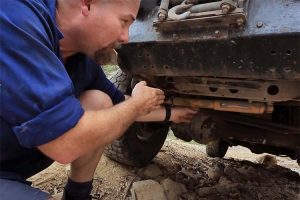Ground clearance is a critical vehicle specification affecting off-road capability, undercarriage protection, and overall performance. This article delves into its importance, measurement techniques, and the optimal clearance for different driving conditions.
Ground clearance is the minimum distance between the lowest part of a vehicle’s chassis and the ground, essential for preventing undercarriage damage during off-road activities or on uneven surfaces. A sufficient ground clearance can prevent many common issues such as undercarriage scraping, which can lead to costly repairs. For off-road vehicles, high ground clearance is crucial as it allows for safer navigation over obstacles like rocks and logs, enhancing the vehicle’s ability to traverse over rough terrain without sustaining damage. Vehicles designed for off-road use typically boast higher ground clearance, facilitating better approach, departure, and breakover angles, thereby improving their ability to tackle steep and uneven paths without harm.
How to Measure Ground Clearance
To accurately measure ground clearance, identify the lowest point of the vehicle’s undercarriage—which may be the exhaust, differential, or another component—depending on the vehicle’s design. Using a measuring tape, measure the vertical distance from this point to a flat ground surface to determine the ground clearance. It’s important to perform this measurement when the vehicle is unladen to get a true reading of its clearance capabilities. Regular monitoring of ground clearance is advised, especially after modifications or changes to the vehicle’s suspension system, which can alter its ride height and potentially affect its performance and suitability for specific terrains.
Optimal Ground Clearance for Various Terrains
The ideal ground clearance for a vehicle largely depends on the terrain it will navigate:
- Flat Dirt Tracks: Typically, 6-8 inches of clearance is sufficient to handle minor obstacles without scraping.
- Rocky Trails: For navigating large rocks and deep ruts safely, a clearance of 10 inches or more is recommended. This helps to ensure the necessary approach, departure, and breakover angles for safely clearing obstacles.
- Mud/Snow: 8-10 inches of clearance is generally enough to manage these softer terrains effectively, allowing for better undercarriage protection against hidden obstacles.
Advanced Technologies Enhancing Ground Clearance

Top Vehicles for High Ground Clearance
When it comes to vehicles that offer superior ground clearance suitable for rugged terrains and off-road adventures, certain models stand out. Here’s a detailed look at some of the top vehicles known for their high ground clearance, making them ideal choices for drivers who prioritize off-road capability:
| Vehicle Model | Ground Clearance | Key Features |
| Toyota 4Runner | 9.6 inches | Robust body-on-frame construction, reliable for both on-road comfort and off-road capability. Available with 4WD and equipped with advanced off-road technologies such as Multi-Terrain Select and Crawl Control. |
| Jeep Wrangler | 10.8 inches | Iconic for its off-road capabilities, the Wrangler offers removable doors and roof, and is equipped with solid front and rear axles for superior durability. It provides various 4×4 systems to tackle the toughest terrains. |
| Ford Bronco | Up to 11.6 inches | Newly reintroduced with a focus on off-road excellence, the Bronco features a terrain management system with up to seven modes, detachable body panels, and advanced 4×4 capabilities. |
| Land Rover Defender | Up to 11.5 inches | Known for its luxury and capability, the Defender offers adjustable air suspension, Terrain Response 2 system, and a robust build for tackling various landscapes. |
| Chevrolet Colorado ZR2 | 8.9 inches | This mid-size truck is built with off-road racing technology including Multimatic shocks and front and rear locking differentials, making it adept for rugged adventures. |
The table above presents vehicles that excel in providing high ground clearance, crucial for navigating through challenging terrains without risking undercarriage damage.
Conclusion
Optimal ground clearance is paramount for enhancing a vehicle’s performance in various environments, especially in off-road conditions. It ensures the protection of the vehicle’s undercarriage while enhancing its ability to navigate through challenging terrains. By understanding the necessary ground clearance required for different terrains and conditions, drivers can better prepare their vehicles to handle such challenges effectively. Whether by selecting a vehicle known for its high ground clearance or by modifying an existing vehicle to improve its capabilities, drivers can achieve superior performance and durability. This guide provides a thorough overview of ground clearance, aimed at helping vehicle owners and enthusiasts make informed decisions about their vehicle’s configuration and readiness for off-road adventures or everyday challenges on rough terrains.

